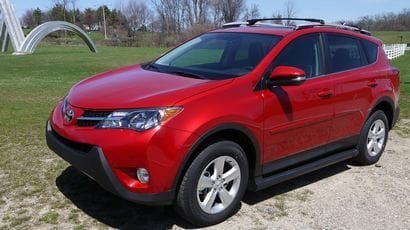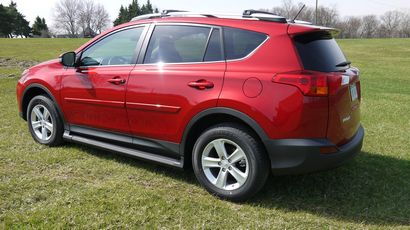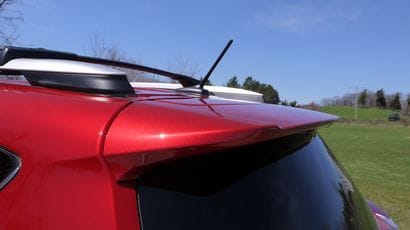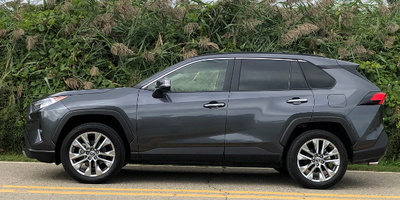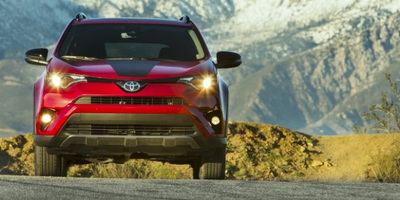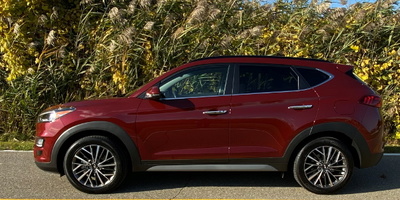Toyota is back in the middle of the small SUV game and we spend a week in the redesigned RAV4
Pros:
Much improved ride and handling
Dashboard layout
Rear seat room
Cons:
Road and wind noise
Firm ride
The original
Back in 1994 Toyota unveiled an all-new sport utility vehicle calling it the RAV4 - the letters of which stood for Recreational Activity Vehicle with 4-wheel drive. In doing so the Japanese manufacturer not only introduced a new model, it created an entirely new vehicle segment – the compact crossover.
That first generation model had a 94.9 inch wheelbase, was 162 inches long, was powered by a 120 horsepower 2-liter engine and was available in the U.S. with either two or four doors. It also featured a rear-mounted spare tire and a swing-out tailgate that was hinged on the passenger side.
Since that time the original RAV4 has been replaced twice by newer generation modesl. But with sales and competition heating up in the segment it created, Toyota has seen its market share eroded by vehicles such as the Subaru Forester, Nissan Rogue and the new Ford Escape as well as last year's market leader, the Honda CR-V.
Clearly it was time for a change.

2013 Toyota RAV4
Revealed at the 2012 Los Angeles Auto Show, the fourth-generation RAV4 remains true to the model's mission while breaking with tradition in one very visible way.
In terms of overall size, Toyota seems to have adhered to the phrase "if it ain't broke, don't fix it." Compared to the previous model its wheelbase remains the same. The new model is shorter by just over an inch and wider by about the same amount and although its overall height is also lower, ground clearance is also down which means the body, itself, is taller by a scant 0.3 of an inch. The front and rear track have also been increased by 0.4 of an inch.
Bigger changes appear under the hood where Toyota has jettisoned the 3.5-liter V-6 engine option. All RAV4s will now come with the 2.5-liter aluminum inline-4 that now produces 176 horses – a loss of 3 hp over last year, and an identical 172 lb.-ft. of torque.
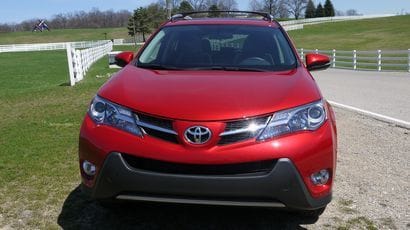
Toyota has also ditched the previous generation's 4-speed automatic in favor of a more advanced unit. The new six-speed tranny features first and second gear ratios that are optimized for around-town driving, while the fifth and sixth gears are both overdrives to improve highway fuel economy. Also aiding those fuel economy numbers is Toyota's "flex lock-up control" which has the ability to lock the transmission's torque converter at speeds as low as 12 mph.
According to EPA figures, fuel economy in 2WD models is up by 2 in the city to 24mpg and by 3 on the highway to 31mpg. Fuel economy in 4WD versions is also improved with an EPA-estimated 22 city/29 highway. My own observed fuel economy in primarily suburban driving clocked in at 25.9 mpg, 0.9 mpg above the EPA's combined city/highway estimate.
All-wheel-drive RAV4s, such as our tester, now feature a Dynamic Torque Control AWD system developed by auto supplier Magna. The system monitors and controls the transfer of engine torque between the front wheels via an electromagnetic coupling in front of the rear differential. It allows a torque distribution anywhere from 100 percent to the front wheels up to and including a 50-50 split between the front and rear wheels.
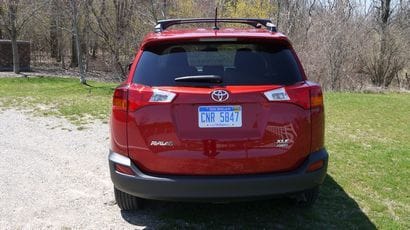
Unlike previous RAV4 models, the new system works in conjunction with various sensors such as speed, steering angle and yaw rate and transfers torque to the rear wheels not only when slip is detected, but also when it detects cornering forces to reduce the load on the front tires and the effects of understeer and improve lateral grip for better handling.
Front drivers, however, are not left out of the engineering mix and feature a system Toyota calls Automatic Limited Slip Differential or "Auto LSD" for short. This system, which is essentially an additional layer of computer logic in the traction control system, can be engaged by the driver at low speeds.
Once engaged and through pulsed application of the front brakes, in low-speed situations under 25 mph it directs power across the front axle and allows some controlled drive-wheel spin to help "dig" the vehicle out of difficult situations such as a snow-covered driveway or a sandy patch of unpaved road.

Styling
Outside the 2013 RAV4 wears all-new sheetmetal while breaking with its heritage in a big way. The newest generation no longer has a spare hanging off its hindquarters. In addition, a top-hinged rear hatch has replaced what I've always considered to be an anachronism, the side-swinging door that has been a part of RAV4 lore since its genesis.
As for the body itself, it strikes a nice middle ground. Although not as sculpted as the Ford Escape, it hardly falls into the league of the stylistically-challenged Nissan Juke or the ranks of the plain vanilla Mitsubishi Outlander and Nissan Rogue.
More specifically, the RAV4's new grille and headlamp enclosures that surround new projector-beam headlights give the front end some individuality, while the pronounced shoulder line, incorporating the large rear taillamp enclosures, gives both its sides and back a distinctive look.

Interior
Inside, Toyota has done away with the optional third row seat where, in its stead, the spare tire now resides. In redoing the interior designers and engineers focused on making the cabin look and feel bigger. Carrying over a theme that began with the 2012 Camry, the RAV4 features a soft stitched lower dash panel and, unlike the Klingon-inspired designs of many small crossover-utes, opts for a much simple and more straightforward arrangement of buttons and knobs. A centrally-located upper dash vent also leaves the lower dash mercifully uncluttered.
A counterpoint to all this goodness, however, is the plethora of cheap-looking trim pieces ranging from the metallic trim strip separating the upper and lower dash and door pulls to the to the plasticky trim surrounding the instrument binnacle and areas of the center console.
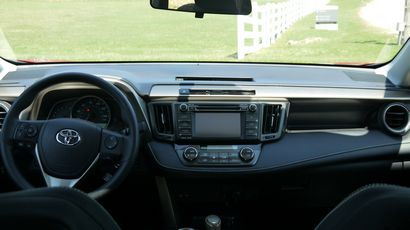
The cabin itself, however, is bright and airy with excellent visibility out the front, sides and back, aided by both a relatively low beltline and narrow D-pillar. The front seats are supportive and nicely bolstered while in front of the driver a silver-trimmed instrumentation cluster features clear, easy to read gauges.
A nice touch is the fact that the center stack flies against current convention and doesn't dominate the rest of the interior. Although it contains a 6.1-inch touchscreen and is surrounded by a CD slot on top, three buttons on each side and an HVAC module below, it appears to float in the middle of the dashboard. That plus a smaller center console creates a feeling of roominess missing from other vehicles in this class.

All these controls are within easy reach of the driver and are both intuitive and silky smooth.
As a testament to the simplicity of its infotainment system I was able to pair an iPhone to it without having to consult the owner's manual – something that has become something of a benchmark around here.

Our XLE tester came with the optional Display Audio with Navigation and Entune. The package includes a 6.1-inch touch screen with integrated backup camera, six speakers, satellite and HD radio with iTunes tagging along with n auxiliary audio jack, USB port and hands-free phone, voice recognition and music streaming via Bluetooth.

On the road
The new RAV4 feels solid and well-planted on the road. Although the short wheelbase means the ride can get busy at times, overall the suspension does a good job of damping out all but the harshest of ruts. It's certainly one of the best-handling vehicles in the class, surpassed only by the Ford Escape and Mazda CX-5. At the same time there's no denying the fact that, despite the attention Toyota engineers paid to noise, vibration and harshness and additional sound-deadening material, a good deal of road, tire and wind noise enters the cabin.
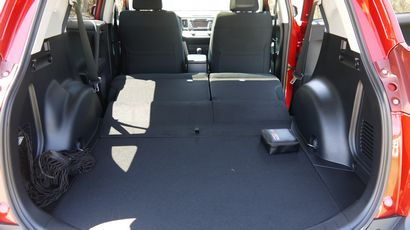
Pricing
Manufacturer suggested retail pricing for the 2013 RAV4, including an $845 delivery, processing and handling fee, starts at $24,145 for a front wheel drive LE and tops out at over $34,000 for a fully-optioned four-wheel-drive Limited.
Our tester, an all-wheel-drive XLE, had a base price of $25,690. Options included the aforementioned Display Audio with Navigation and Entune ($1,030), roof rack cross bars ($229), body side molding ($209), and running boards ($549). Including the destination and delivery charge, the MSRP came to precisely $28,552.
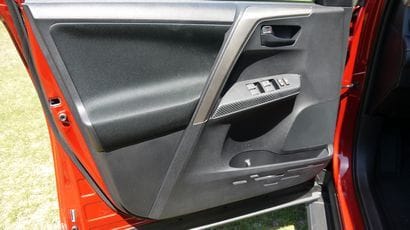
The Bottom Line
Although the RAV4 was the first out of the starting block, Toyota appears to have become complacent in the intervening years as the all-new model only manages to land just above the middle of the pack in terms of its overall performance.
But the fact of the matter is that many buyers in this segment are more interested in reliability and resale value – two areas that Toyota excels in.
Those qualities, plus a new interior, a better transmission and improved chassis dynamics should entice current owners as well as many more potential customers to pay a visit to their local Toyota dealer.


